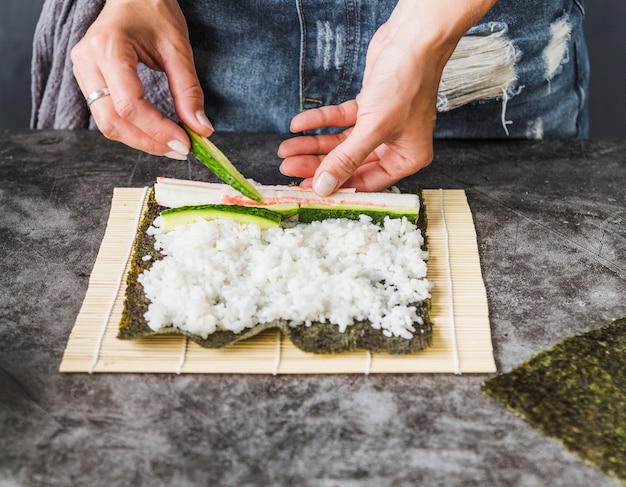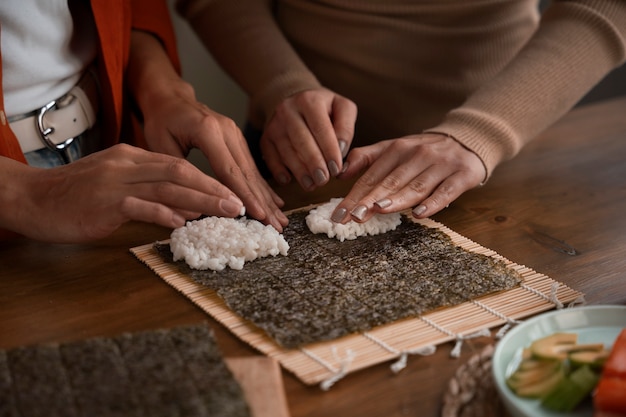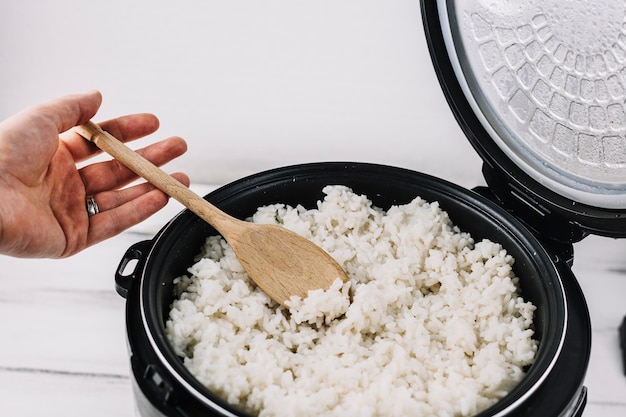Let's face it, rice is a kitchen staple. We all have our go-to rice dishes, whether it's a simple side for a hearty roast or the star of the show in a fragrant curry. But getting rice just right can feel like a bit of a culinary mystery, especially when you're faced with a pot of mushy or undercooked grains.
I've been there, trust me. From clumpy rice disasters to perfectly fluffy grains, I've learned a thing or two about mastering the art of rice cooking. I'm going to share my secrets with you, from choosing the right rice to understanding the science behind perfect cooking times. So grab a cuppa, settle in, and let's get cooking!
Part 1: The Fundamentals of Rice Cooking: A Guide to Perfect Grains

Rice might seem like a simple ingredient, but there's a surprising amount to learn about its various types and the best methods for cooking them. Let's start with the basics, because a solid foundation is key to achieving rice perfection.
Choosing the Right Rice: A World of Grains
The first step to perfect rice is choosing the right variety for your dish. Different types of rice have unique qualities, such as grain shape, texture, and cooking time. So, let's explore some of the most popular varieties:
- basmati rice: The long, slender grains of basmati rice are known for their delicate fragrance and fluffy texture. They cook quickly and are perfect for Indian and Middle Eastern dishes like biryani and pilafs, as well as salads and stir-fries. The aroma of basmati rice cooking always takes me back to my childhood, full of warmth and delicious memories.
- jasmine rice: Jasmine rice is another long-grained variety, renowned for its fragrant, slightly floral aroma and soft, fluffy texture. It's ideal for Thai curries, stir-fries, and even as a bed for your favourite grilled proteins. Jasmine rice has a more subtle flavour than basmati, making it a versatile choice for many dishes.
- brown rice: A nutritious choice packed with fibre and nutrients, brown rice is a whole grain that has a nutty flavour and a slightly chewier texture than white rice. It takes a bit longer to cook but offers a more substantial feel to your meals. While it's not my personal favourite, I know it's a healthy option that deserves a spot in your kitchen.
- arborio rice: The star of the show when it comes to creamy risotto, arborio rice has short, plump grains that release a lot of starch during cooking, creating that signature luxurious texture. It's also a great choice for rice pudding and other creamy rice dishes.
- wild rice: Technically a grass, not a rice, wild rice has a unique nutty flavour and a chewy texture. It's a bit more expensive than other varieties, but its earthy flavour and hearty texture make it worth trying.
Understanding the Ratio: It's All About Balance
Just like any good recipe, the key to perfect rice lies in the perfect balance of ingredients. The water-to-rice ratio is essential for achieving the desired texture, whether it's fluffy and separate or slightly sticky.
A good starting point is a 1:1 ratio of rice to water, but this can vary depending on the type of rice you're using. Always check the package instructions for the recommended ratio.
The Right Pot Matters: Cooking with Confidence
You don't need a fancy gadget to cook perfect rice. A simple pot with a tight-fitting lid is all you need. This is key for trapping steam and ensuring the rice cooks evenly. A saucepan with a heavy base is also ideal, as it will distribute heat evenly and prevent the rice from sticking.
Part 2: The Art of Rice Cooking: A Step-by-Step Guide to Perfect Grains

Now that we've covered the fundamentals, let's dive into the process of cooking rice. Follow these steps for perfect rice every time:
Step 1: Rinsing Your Rice
This might seem like an unnecessary step, but rinsing your rice before cooking is crucial for removing excess starch. Excess starch can lead to sticky, clumpy rice. To rinse your rice, simply place it in a strainer and run cold water over it until the water runs clear.
Step 2: The Perfect Ratio: Adding Rice and Water to the Pot
Pour the rinsed rice into your pot. Add the recommended amount of water or broth, based on the type of rice you're using. Remember, the package instructions are your best guide for this step.
Step 3: Bringing the Rice to a Boil
Place the pot on the stove and bring the mixture to a boil over medium heat. This will ensure the rice cooks evenly and starts to soften.
Step 4: Reducing Heat and Simmering
Once the water is boiling, reduce the heat to a simmer. Cover the pot with the lid and let the rice simmer for the recommended time. This is where the magic happens. The simmering process allows the rice to absorb the liquid and cook through.
Don't peek! It might be tempting, but resist the urge to lift the lid during cooking. This will release steam and disrupt the cooking process, leading to unevenly cooked rice.
Step 5: Resting Your Rice
When the cooking time is up, remove the pot from the heat. Let the rice rest, covered, for 5-10 minutes before fluffing it with a fork. This allows the steam to distribute evenly, resulting in fluffier, more perfectly cooked rice.
Part 3: Mastering the Art of Rice: Tips and Tricks

Now, let's explore some insider tips and tricks that will help you elevate your rice cooking game.
Adding Flavour: Beyond the Basics
Who says rice has to be bland? You can add incredible depth of flavour with a few simple additions. Here are some of my favourite flavour-boosting ideas:
- Spice it Up: A bay leaf, a sprig of thyme, or a pinch of saffron can add subtle yet delicious flavour to your rice. Experiment with different herbs and spices to find your personal favourites.
- Broth Power: chicken broth or vegetable broth adds a rich and savoury flavour to rice. Use broth instead of water for a more complex taste.
- Citrus Twist: A squeeze of lemon or lime juice before serving can brighten up the flavours of your rice. A touch of citrus zest adds a refreshing, tangy note.
The Importance of Timing: Don't Overcook!
The key to perfect rice is knowing when to stop. Overcooking can lead to mushy, unappetising rice. So, keep a close eye on the cooking time. You can even test for doneness a bit early to ensure it doesn't get overcooked.
Fluffing It Up: A Simple Technique for Perfect Grains
Once the rice is cooked, use a fork to gently fluff it. This helps to separate the grains and prevent them from sticking together. Fluffing the rice also helps it cool down faster, preventing further cooking.
Part 4: rice recipes: From Simple to Savoury
Ready to put your new rice knowledge into action? Here are a few recipes to get you started, showcasing the versatility of rice in different dishes:
Basic White Rice: A Kitchen Staple
This classic recipe is perfect as a simple side dish for a variety of meals. It's also a great base for more elaborate dishes.
Ingredients:
- 1 cup white rice
- 2 cups water
- 1/2 teaspoon salt
Instructions:
- Rinse the rice in a strainer until the water runs clear.
- Place the rice in a pot with the water and salt.
- Bring the mixture to a boil, then reduce the heat to a simmer.
- Cover the pot and simmer for 15-20 minutes, or until the rice is cooked through.
- Fluff the rice with a fork and serve.
fried rice: A Quick and Delicious Meal
Fried rice is a classic Asian dish that's perfect for a quick and delicious meal. It's incredibly versatile and can be customized with your favourite ingredients.
Ingredients:
- 2 cups cooked white rice
- 2 tablespoons vegetable oil
- 1 egg, beaten
- 1/2 cup chopped onion
- 1/2 cup chopped carrots
- 1/2 cup chopped peas
- 1/4 cup soy sauce
- 1 tablespoon sesame oil
- Salt and pepper to taste
Instructions:
- Heat the vegetable oil in a large skillet over medium heat.
- Pour in the beaten egg and scramble until cooked through.
- Add the onion, carrots, and peas to the skillet and stir-fry for 5 minutes, or until the vegetables are tender-crisp.
- Add the cooked rice to the skillet and stir to combine.
- Add the soy sauce, sesame oil, salt, and pepper and stir to combine.
- Serve immediately.
risotto with mushrooms: A Creamy Italian Delight
Risotto is a creamy, comforting Italian rice dish that's perfect for a special occasion or a cozy dinner.
Ingredients:
- 1 cup arborio rice
- 1/2 cup dry white wine
- 4 cups chicken broth
- 1/4 cup butter
- 1/4 cup grated Parmesan cheese
- 1/2 cup chopped mushrooms
- 1 tablespoon olive oil
- Salt and pepper to taste
Instructions:
- Heat the olive oil in a large saucepan over medium heat.
- Add the mushrooms to the saucepan and sauté for 5 minutes, or until softened.
- Add the rice to the saucepan and stir for 1 minute, or until the rice is coated in oil.
- Pour in the white wine and stir until it's absorbed by the rice.
- Add 1 cup of the hot chicken broth to the saucepan and stir until it's absorbed by the rice.
- Continue adding the chicken broth, 1 cup at a time, stirring until each cup is absorbed by the rice, before adding the next.
- Cook for about 20 minutes, or until the rice is creamy and cooked through.
- Stir in the butter and Parmesan cheese until melted.
- Season with salt and pepper to taste.
- Serve immediately.
Part 5: The Science of Rice Cooking: Understanding the Process
Let's delve deeper into the science behind perfect rice. By understanding the process, you can troubleshoot any rice-related challenges.
The Importance of Starch
Starch is the key player in rice cooking. It's what gives rice its texture, whether it's fluffy, sticky, or creamy. When rice cooks, the starch granules absorb water and swell, which is what creates the cooked texture.
The Role of Steam
Steam plays a crucial role in rice cooking. Trapping the steam in the pot helps to cook the rice evenly and prevent it from drying out. That's why a tight-fitting lid is so important!
The Effect of Overcooking
Overcooking rice can result in mushy grains because the starch granules have absorbed too much water and broken down. This is why it's essential to follow the recommended cooking times and check for doneness a bit early.
Part 6: Rice Substitutes: Expanding Your Culinary Horizons
While rice is a fantastic staple, sometimes you might be looking for a substitute. Perhaps you're exploring different flavours or trying to switch up your diet. Here are some delicious and healthy alternatives:
Quinoa: A Complete Protein
A complete protein, quinoa is a great rice substitute with a slightly nutty flavour and a light, fluffy texture. It's gluten-free and packed with nutrients, making it a nutritious and versatile choice.
Couscous: A Quick and Easy Option
Couscous is a type of pasta made from semolina. It's often served as a side dish or used in salads. It's quick and easy to cook and has a slightly grainy texture.
bulgur wheat: A Hearty and Nutty Choice
Bulgur wheat is a type of cracked wheat that's often used in Middle Eastern and Mediterranean cuisine. It has a nutty flavour and a chewy texture. It's also a good source of fibre and protein.
Freekeh: A Smoky and Chewy Grain
Freekeh is a type of green wheat that's roasted and then dried. It has a smoky flavour and a chewy texture. It's also a good source of protein and fibre.
Part 7: A Rice Storage Guide: Keeping Your Grains Fresh
To make sure your rice stays fresh and delicious, follow these simple storage tips.
Storing Uncooked Rice
Uncooked rice can be stored in an airtight container in a cool, dark place for up to six months. This will help to keep it free from moisture and pests.
Storing Cooked Rice
Cooked rice can be stored in an airtight container in the refrigerator for up to 3 days. You can also freeze cooked rice for up to 3 months. To reheat frozen rice, microwave it on high until heated through.
Storage Tips
Here are a few extra tips for storing rice:
- Avoid Plastic Bags: Don't store rice in plastic bags, as they can absorb moisture and affect the quality of the rice.
- Keep it Dry: If you're storing rice for a long time, consider putting a bay leaf or a few cloves in the container to absorb moisture and keep the rice fresh.
Part 8: FAQs: Your Rice Cooking Questions Answered
Now, let's tackle some of the most common rice-related questions!
Q1: What if I overcook my rice?
Oh dear, we've all been there! Don't worry, it's not the end of the world. Overcooked rice can become a bit mushy, but there are a few things you can try:
- Use it for Fried Rice: Overcooked rice is perfect for fried rice. The extra moisture will help it absorb the flavours of the other ingredients.
- Make Rice Pudding: If you've got a sweet tooth, overcooked rice can be used to make a delicious rice pudding. It'll give it a lovely creamy texture.
- Don't Throw it Away: There's always a way to repurpose overcooked rice. Don't despair, just get creative!
Q2: Can I cook rice in the microwave?
Yes, you can! You can cook rice in the microwave, but the results might not be as good as cooking it on the stovetop. You'll want to use a microwave-safe bowl with a tight-fitting lid. Follow the instructions on the package, and make sure you stir the rice halfway through cooking to ensure it cooks evenly.
Q3: What should I do if my rice is too dry?
Don't panic! If your rice is too dry, you can add a little bit of water and let it simmer for a few more minutes. It's also a good idea to fluff the rice with a fork to help it absorb the additional water.
Q4: What's the best way to reheat rice?
To reheat cooked rice, you can use the microwave, stovetop, or oven. Here are some tips for reheating rice:
- Microwave: Add a tablespoon of water to the rice and microwave on high for 1-2 minutes, or until heated through.
- Stovetop: Add a tablespoon of water to the rice and heat it over low heat, stirring occasionally, until warmed through.
- Oven: Preheat the oven to 350 degrees F (175 degrees C). Spread the rice in a baking dish and bake for 15-20 minutes, or until heated through.
Q5: Is there a way to make rice stickier?
Yes, you can make rice stickier by adding a bit of cornstarch or flour to the cooking water. You can also add a teaspoon of rice vinegar for a more pronounced sticky texture. This is especially helpful if you're using your rice for sushi or dumplings.
Well, there you have it! A comprehensive guide to cooking perfect rice, from choosing the right type to adding flavour and serving it up with style. With a little practice, you'll be a rice-cooking master in no time.
Everyone is watching

How to Cook Frozen Lobster Tails Perfectly: A Step-by-Step Guide
RecipesLobster. Just the word conjures up images of lavish meals, special occasions, and a taste of luxury. But let's...

Pigs in a Blanket Cooking Time: How Long to Bake for Perfect Results
RecipesAh, pigs in a blanket. Just the name conjures up images of those delightful little parcels of crispy pastry en...

Pork Fillet Cooking Time: How Long to Cook It Perfectly
RecipesPork fillet, or tenderloin as it's sometimes called, is a real favourite in our house. It's so versatile, and...

The Ultimate Guide to Cooking Delicious Frankfurters
RecipesLet's face it, we all love a good frankfurter. It's a classic, simple, and always satisfying. But let's be rea...

The Ultimate Guide to Tender, Juicy Pulled Pork
RecipesRight, let's talk pulled pork. It's one of those dishes that just screams "comfort food," doesn't it? I mean...
